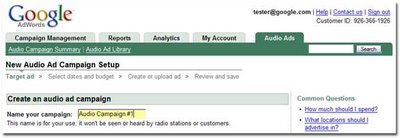
The cost per thousand impressions is a measure that marketers use in order to evaluate the success or failure of their advertising campaigns. It is calculated using the total ad purchase cost divided by the estimated number of views that the ad would receive. While CPM can be used to measure the efficiency of a media campaign's media campaigns, it is not all that important.
Ad spend and ad effectiveness are important aspects to consider when evaluating the effectiveness of an advertising campaign. Tracking ad spend is important, but ad performance can also be affected by variables such as conversion rates. Cost per click ads are a great option for attracting new customers. This type of ad is less expensive than CPM. However, this ad type is less predictable so it isn’t always a great choice.
To figure out whether your ad campaign is successful, you need to measure the click-through rate (CTR). CTR is usually two clicks for every 100 impressions. Depending upon the medium, it is possible to increase the CTR with different ad formats. Rich media advertising can increase your ad's reachability.

Other metrics that can be used for evaluating ad performance are the average click rate and number of unique users. These statistics will help you establish expectations for your ad. Monitor your ad performance throughout time. This is the best way.
CPC is more complicated than CPM. CPC is difficult to predict revenue and it is less likely that CPC will generate high quality impressions. CPC revenues can also redirect visitors to your site. CPC revenue can be reduced if you have a well-designed advertising program.
CPC is a more effective ad model than CPM for online publishers. They can collect more data and optimize ad sales. However, the risk of switching from CPM to CPC can be increased. CPC is believed to be more profitable than CPM due to its higher return on investment. But this isn’t always true.
Higher CPMs do not necessarily indicate better earnings. However, they are an indicator that your ad has been generating good traffic. Advertisers may also be able reach a larger audience for a lower cost per thousand impressions. CPM doesn't have the same value as brand awareness. CPM does not predict whether a product such as a degreaser will be sold.

CPM rates vary from one market or the next. A magazine with large readers will pay less per thousand dollars than a publication with a smaller readership. Targeting a niche audience may also mean that the cost per ad is higher. A cost-benefit analysis is a must when evaluating your advertising strategy.
FAQ
What is branding exactly?
Your brand is your way of communicating who you are as well as what you stand behind. It is how people remember your name.
Branding involves creating an identity that makes your company stand out. A brand isn't just a logo. It also includes everything you do, including your physical appearance as well as the tone of voice that employees use.
Customers feel more confident buying from your company if they have a solid brand. They know what they're getting. This gives customers the confidence to choose your products over other brands.
Apple is a prime example of a company with a strong brand. Apple's brand is well-known for its stylish design, high-quality products and outstanding customer support.
Apple's name is synonymous with technology. Apple is what people think about when they see a smartphone, computer or tablet.
If you're considering starting a new business, you should consider developing a brand before launching. This will give your company a face and personality.
What is advertising's primary purpose?
Advertising isn’t about selling products.
Advertising is all about communicating ideas and values with people who are already interested. It's about changing minds and attitudes. It's about building connections.
It's all about making people feel good about themselves.
You can't sell to your customers if you don’t know their needs.
So before you start any advertising project, you should first understand your customer's needs and wants, and buying habits.
Then, you can create ads that resonate.
What do you need to know about television advertising?
Television advertising has the potential to reach large audiences at once. It was also quite expensive. However, if you use it well, it can be incredibly powerful.
Although there are many types of TV ads available, they all share certain characteristics. The first thing to remember when planning any type of TV ad is to ensure it fits into its category. You shouldn't attempt to make a lifestyle commercial the same as a product ad. Your message should be consistent across the entire campaign.
It is important to remember that ads are best aired during prime-time. This is because TV viewers often relax while in front of the screen. You want them to be relaxed enough to focus on your words.
You don't have to be rich to achieve great results. In fact, the opposite may be true. A University of California study found that commercials broadcast during popular shows had a lower chance of selling products than those broadcast during less-popular shows. So, if you spend a lot of money on TV advertising, ensure you do it right.
What is affiliate marketing?
Affiliate marketing is an online model that allows you to earn commissions for referring customers to other websites. You get paid by the product owner when someone buys from them.
Affiliate marketing is based on referrals. Referring people to your website is all that's required. You just need to refer them to our website.
There are many ways to make money, without having to do any selling. Selling is as easy as buying.
Even affiliate accounts can be set up in just minutes.
The more people you refer, the more commission you will receive.
There are two types:
-
Affiliates who have their own websites
-
Affiliates who work in companies that offer products or services.
What is an advertising buyer?
An advertiser buys advertising space on TV, radio, print media, etc.
Advertisers are paid for the time that their message will appear.
They don't necessarily seek the best ad; they want to reach their target markets with the most effective ad.
The advertiser may have specific demographic information about their potential customers, such as age, gender, income level, marital status, occupation, hobbies, interests, etc.
This data can be used by the advertiser to decide which media is most effective for them. Direct mail might be more effective with older customers, for example.
Advertisers also take into account the competition. Advertisers may choose to place ads near competitors if there are similar businesses in the area.
Advertisers must also take into account the size of their budget as well as the time it will take to spend the money before it expires.
Advertising: What is it?
Advertising is an art. It's more than just selling products. It's all about creating emotional connections between people with brands.
Advertising is about telling stories and using images to communicate ideas.
You must communicate clearly and persuasively. And you need to tell a story that resonates with your target market.
Advertising is thus different from other forms, such public speaking, writing, and presentations.
You are building a brand identity when you run a successful advertising campaign.
This is how to be remembered. People want to remember you.
What is an advertising campaign?
Advertising campaigns are a series or advertisements that promote a product. It could also refer the entire production of such advertisements.
"Ad" is a Latin word that means "to sell." The first known use was by Marcus Terentius Varro (116-27 BC), who used it as a verb meaning "to make a sale."
Advertising campaigns are often carried out by large agencies or companies. Advertising campaigns can involve many media types, such as television, radio, print, and the internet.
Advertising campaigns are typically long-lasting and have clear goals. Advertising campaigns can have different goals. Some are focused on increasing sales while others generate awareness.
Statistics
- Nonetheless, advertising spending as a share of GDP was slightly lower – about 2.4 percent. (en.wikipedia.org)
- This means that at least 50% of an ad needs to be shown on the screen for at least one second. (quicksprout.com)
- Google will display whichever ad type (CPM or CPC) is expected to earn more revenue for the publisher, which is in Google's best interest since they take a 32% share of the revenue. (quicksprout.com)
- Worldwide spending on advertising in 2015 amounted to an estimated US$529.43 billion. (en.wikipedia.org)
External Links
How To
How do you place an advertisement on a billboard
Billboards were popularized by the United States Army during World War II. They became a standard fixture along roadsides and highways. Most billboards contain text advertising. However, some have photographs or art. Most billboards are static. However, others display messages that can change often, such as weather forecasts or stock prices.
Although most billboards can be found outdoors, there are also indoor options. The majority of outdoor billboards are visible to traffic frequently, while indoor versions may be seen only once every few years. The most common outdoor billboard style is the "cubic". It is made from three layers -- two sheets each of glass and a layer with fiberglass mesh. This design allows air to circulate through the billboard, keeping it cool in hot weather and warm in cold weather.
Billboard Advertising Inc. is a company that advertiser pay to have their ads displayed on its billboards. It owns and operates many North America's largest billboard advertising companies. Advertisers are then offered space on these billboards by these companies. These spaces are sold to advertisers depending on the amount they plan to spend on advertising. Advertisers often select the best places for their ads based upon where people walk and drive the most.
Billboard Advertising Inc. contracts with local governments in order to erect signs within city limits. Some cities allow billboards everywhere, others only in certain areas. Chicago for instance requires billboards not to exceed 1,000 feet from any highway. Other cities stipulate that billboards must be at least 500 feet away from any school or church.
Billboard Advertising Inc. has agreements to promote products and/or services throughout the United States.